产品号 #60103_C
抗小鼠 NK1.1 (CD161) 的 (C3H x BALB/c) F1 杂交单克隆IgG2a抗体
PK136抗体可特异性识别小鼠NK1.1(CD161)。CD161是一种约80 kDa的同型二聚体2型跨膜糖蛋白和C型凝集素受体,在小鼠NK细胞、NK-T细胞以及特定小鼠品系的稀有T细胞和单核细胞的亚群中表达。NK1.1由Klrb1b和Klrb1c基因编码,这两个基因分别编码CD161b和CD161c多肽。CD161b仅在Swiss NIH和SJL小鼠中表达,CD161c在某些品系如C57BL、FVB/N和NZB中表达,但不在A、AKR、BALB/c、CBA/J、C3H、C57BR、C58、DBA/1、DBA/2、NOD、SJL或129中表达。NK1.1在调节多种生理过程方面发挥功能性作用,包括NK细胞的激活和增殖、诱导干扰素-γ的产生以及释放细胞毒性颗粒。IL-12特异性上调其在细胞表面的表达。对于NK1.1-株的NK细胞检测,推荐使用抗小鼠CD49b抗体,克隆DX5(产品号 #60020)。DX5识别CD49b(整合素α2),这是另一种常用的NK细胞标志物。
亚型
一抗
靶抗原
NK1.1 (CD161)
别名
CD161b,CD161c,Klrb1b,Klrb1c,Ly-55,Ly-59,NK-1.1,NKRP1,NKRP1a,NKRP1b
活性物种
小鼠
偶联
Biotin 或 生物素,FITC,PE,未偶联的
宿主物种
小鼠
细胞类型
NK 细胞
种属
小鼠
应用
细胞分选,CyTOF,删除,流式细胞术,功能学筛选,免疫细胞化学,免疫荧光,免疫组化,免疫沉淀
研究领域
免疫
克隆
PK136
基因编号
17059
同种型
IgG2a,kappa
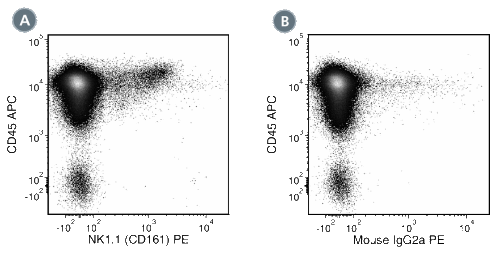
Figure 1. Data for Unconjugated
(A) Flow cytometry analysis of C57BL/6 mouse splenocytes (gated on lymphocytes) labeled with Anti-Mouse NK1.1 (CD161) Antibody, Clone PK136, followed by a rat anti-mouse IgG2a antibody, PE and Anti-Mouse CD45 Antibody, Clone 30-F11, APC (Catalog #60030AZ). (B) Flow cytometry analysis of C57BL/6 mouse splenocytes (gated on lymphocytes) labeled with Mouse IgG2a, kappa Isotype Control Antibody, Clone MOPC173 (Catalog #60071), followed by a rat anti-mouse IgG2a antibody, PE and Anti-Mouse CD45 Antibody, Clone 30-F11, APC.
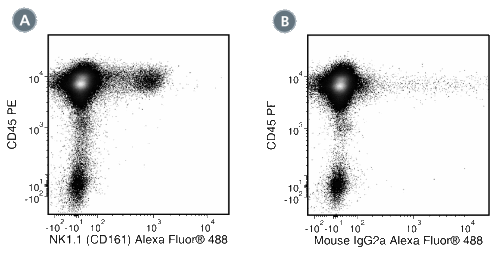
Figure 2. Data for Alexa Fluor® 488-Conjugated
(A) Flow cytometry analysis of C57BL/6 mouse splenocytes (gated on lymphocytes) labeled with Anti-Mouse NK1.1 (CD161) Antibody, Clone PK136, Alexa Fluor® 488 and Anti-Mouse CD45 Antibody, Clone 30-F11, PE (Catalog #60030PE). (B) Flow cytometry analysis of C57BL/6 mouse splenocytes (gated on lymphocytes) labeled with Mouse IgG2a, kappa Isotype Control Antibody, Clone MOPC-173, Alexa Fluor® 488 (Catalog #60071AD) and Anti-Mouse CD45 Antibody, Clone 30-F11, PE.
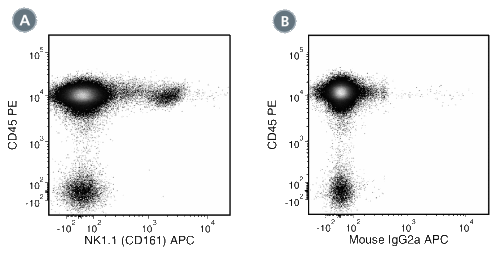
Figure 3. Data for APC-Conjugated
(A) Flow cytometry analysis of C57BL/6 mouse splenocytes (gated on lymphocytes) labeled with Anti-Mouse NK1.1 (CD161) Antibody, Clone PK136, APC and Anti-Mouse CD45 Antibody, Clone 30-F11, PE (Catalog #60030PE). (B) Flow cytometry analysis of C57BL/6 mouse splenocytes (gated on lymphocytes) labeled with Mouse IgG2a, kappa Isotype Control Antibody, Clone MOPC173, APC (Catalog #60071AZ) and Anti-Mouse CD45 Antibody, Clone 30-F11, PE.
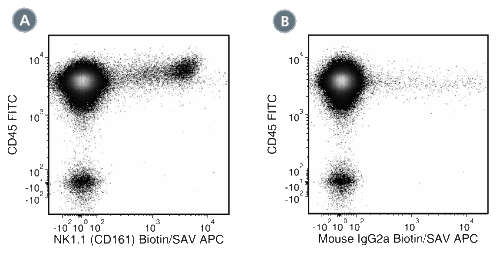
Figure 4. Data for Biotin-Conjugated
(A) Flow cytometry analysis of C57BL/6 mouse splenocytes (gated on lymphocytes) labeled with Anti-Mouse NK1.1 (CD161) Antibody, Clone PK136, Biotin, followed by streptavidin (SAV) APC and Anti-Mouse CD45 Antibody, Clone 30-F11, FITC (Catalog #60030FI). (B) Flow cytometry analysis of C57BL/6 mouse splenocytes (gated on lymphocytes) labeled with Mouse IgG2a, kappa Isotype Control Antibody, Clone MOPC173, Biotin (Catalog #60071BT), followed by SAV APC and Anti-Mouse CD45 Antibody, Clone 30-F11, FITC.
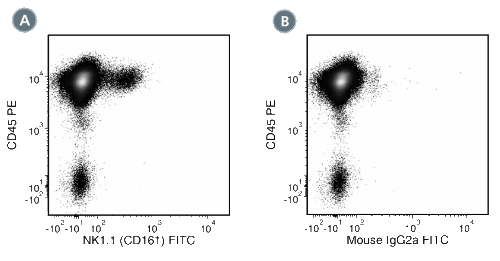
Figure 5. Data for FITC-Conjugated
(A) Flow cytometry analysis of C57BL/6 mouse splenocytes (gated on lymphocytes) labeled with Anti-Mouse NK1.1 (CD161) Antibody, Clone PK136, FITC and Anti-Mouse CD45 Antibody, Clone 30-F11, PE (Catalog #60030PE). (B) Flow cytometry analysis of C57BL/6 mouse splenocytes (gated on lymphocytes) labeled with Mouse IgG2a, kappa Isotype Control Antibody, Clone MOPC173, FITC (Catalog #60071FI) and Anti-Mouse CD45 Antibody, Clone 30-F11, PE.
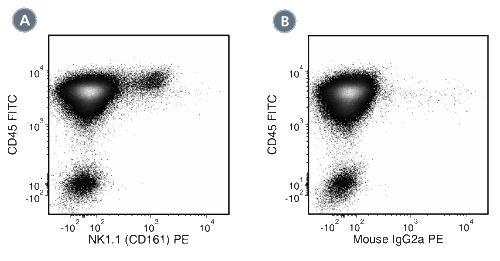
Figure 6. Data for PE-Conjugated
(A) Flow cytometry analysis of C57BL/6 mouse splenocytes (gated on lymphocytes) labeled with Anti-Mouse NK1.1 (CD161) Antibody, Clone PK136, PE and Anti-Mouse CD45 Antibody, Clone 30-F11, FITC (Catalog #60030FI). (B) Flow cytometry analysis of C57BL/6 mouse splenocytes (gated on lymphocytes) labeled with Mouse IgG2a, kappa Isotype Control Antibody, Clone MOPC-173, PE (Catalog #60071PE) and Anti-Mouse CD45 Antibody, Clone 30-F11, FITC.
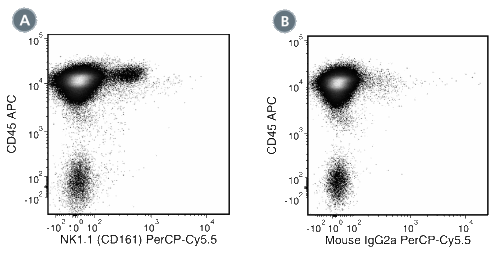
Figure 7. Data for PerCP-Cy55-Conjugated
(A) Flow cytometry analysis of C57BL/6 mouse splenocytes (gated on lymphocytes) labeled with Anti-Mouse NK1.1 (CD161) Antibody, Clone PK136, PerCP-Cy5.5 and Anti-Mouse CD45 Antibody, Clone 30-F11, APC (Catalog #60030AZ).
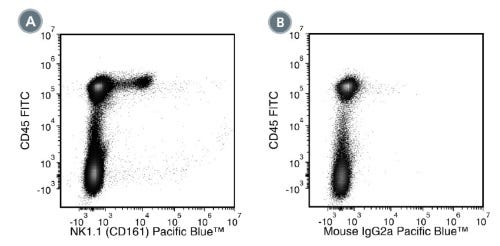
Figure 8. Data for PB-Conjugated
(A) Flow cytometry analysis of C57BL/6 mouse splenocytes (gated on lymphocytes) labeled with Anti-Mouse NK1.1 (CD161) Antibody, Clone PK136, Pacific Blue™ and Anti-Mouse CD45 Antibody, Clone 30-F11, FITC (Catalog #60030FI). (B) Flow cytometry analysis of C57BL/6 mouse splenocytes (gated on lymphocytes) labeled with a mouse IgG2a, kappa Pacific Blue™ isotype control antibody and Anti-Mouse CD45 Antibody, Clone 30-F11, FITC.
Find supporting information and directions for use in the Product Information Sheet or explore additional protocols below.
This product is designed for use in the following research area(s) as part of the highlighted workflow stage(s). Explore these workflows to learn more about the other products we offer to support each research area.
Thank you for your interest in IntestiCult™ Organoid Growth Medium (Human). Please provide us with your contact information and your local representative will contact you with a customized quote. Where appropriate, they can also assist you with a(n):
Estimated delivery time for your area
Product sample or exclusive offer
In-lab demonstration
| Species | Mouse |
|---|---|
| Clone | PK136 |
| Gene Id | 17059 |
| Alternative Names | CD161b, CD161c, Klrb1b, Klrb1c, Ly-55, Ly-59, NK-1.1, NKRP1, NKRP1a, NKRP1b |
| Isotype | IgG2a, kappa |
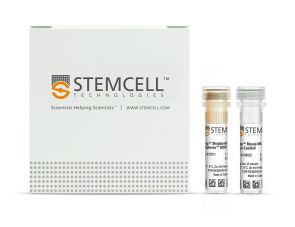
免疫磁珠负选不带标记的小鼠NK细胞
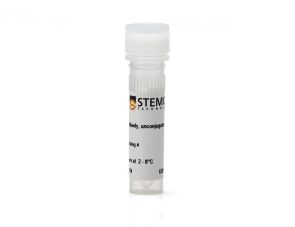
大鼠单克隆IgM抗体,抗小鼠CD49b(整合素α2)
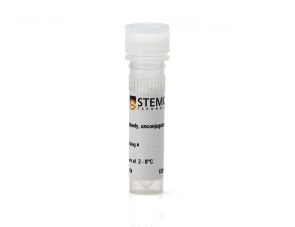
小鼠单克隆IgG2a, kappa同型对照抗体
扫描二维码或搜索微信号STEMCELLTech,即可关注我们的微信平台,第一时间接收丰富的技术资源和最新的活动信息。
如您有任何问题,欢迎发消息给STEMCELLTech微信公众平台,或与我们通过电话/邮件联系:400 885 9050 INFO.CN@STEMCELL.COM。

